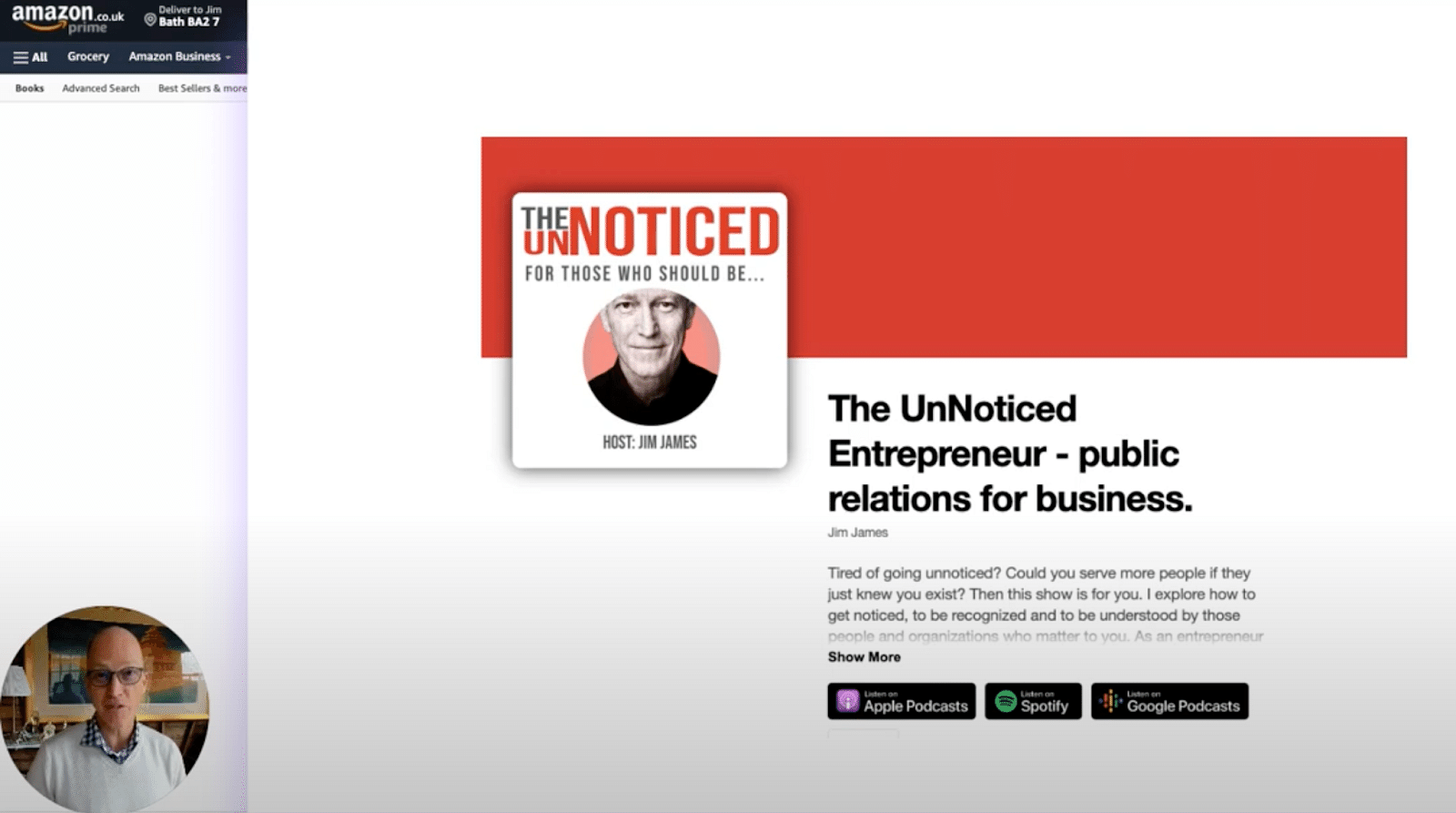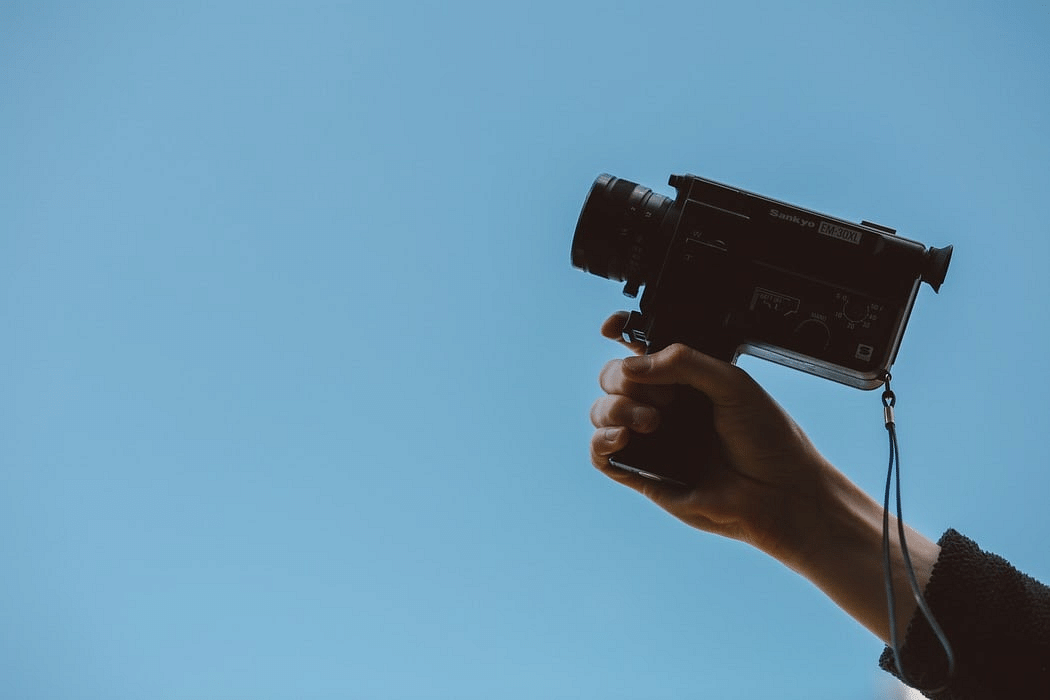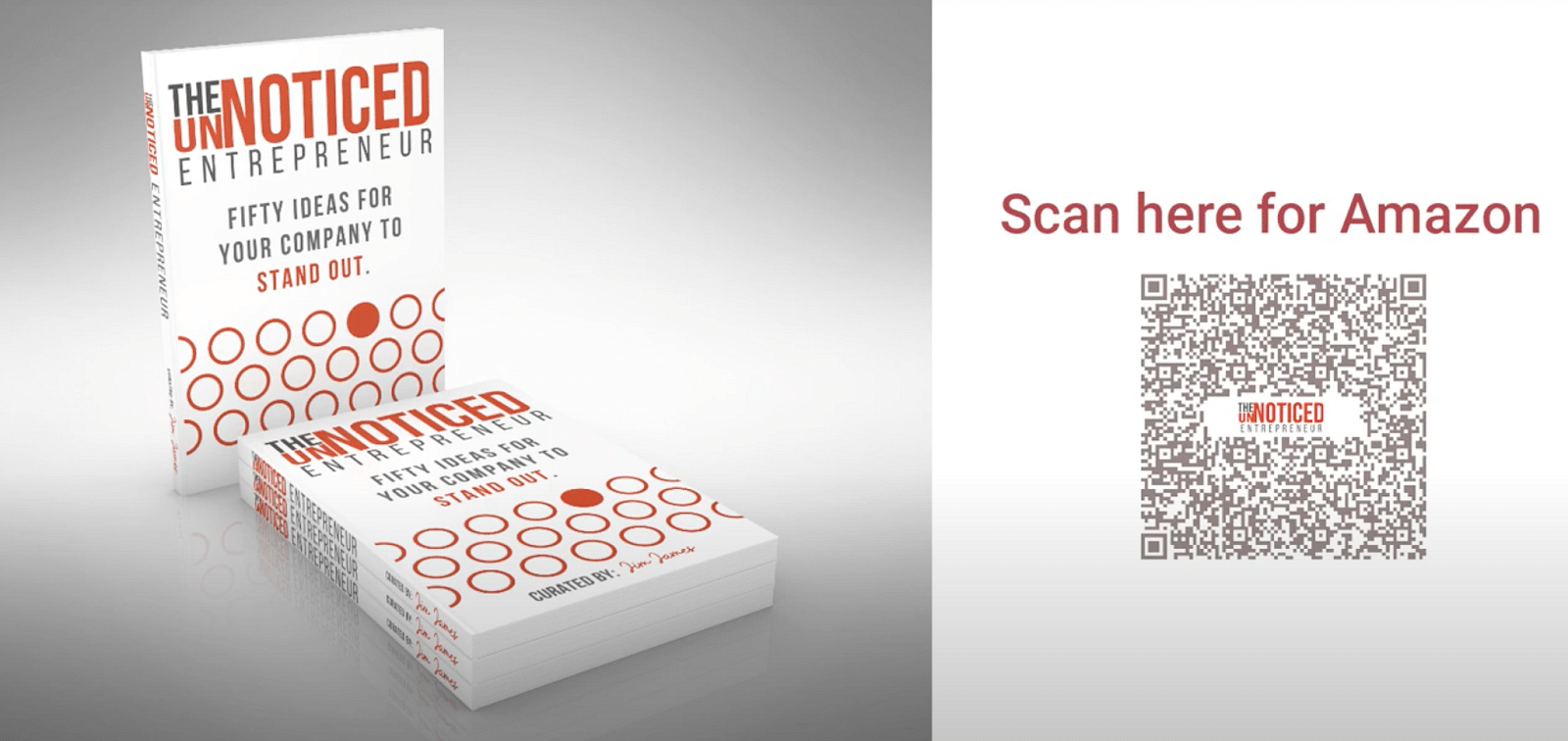
Skip ordinary emails. Here’s how to make engaging call-to-action videos for your book’s pre-orders.
By Jim James, Host of The UnNoticed Entrepreneur.
In the latest episode of my podcast, I shared how I made a video inviting the guests on my The UnNoticed Entrepreneur book to pre-order. Though you may not be doing a pre-order invite, I thought that this topic can be helpful as you reach out to your customers, partners, or staff members to convey messages.
In the podcast, I talked about my learning journey on how to make a three-minute invitation video — complete with links and quick response codes (QRC) — to get people onto Amazon and Barnes and Noble and pre-order. Through it, you can learn how to produce one at a low cost using readily available technologies.
The Rationale
When we reach out to people, we often do so with writing. Yet, we know that video is many times more impactful than writing. The same is true with audio because it’s a medium that’s more intimate.
However, with video, you could gain all the benefits of the picture authority effect. It states that our brains process pictures in a way that attaches them to meaning. And it does that in a more powerful manner than how text can. This is because texts need to be interpreted by the brain differently.
Image from Unsplash
It’s a long story and I learned it through some research I did for my SPEAK|PR program. But to cut it short — we all know that a picture is worth a thousand words; with video, you can multiply that because there are 28 frames per second in standard moving images. Just imagine if one frame is already worth a thousand words, how much more would 28 frames per second be?
The Goal and the Challenge
I want to have the people that took part in my The UnNoticed Entrepreneur book pre-order. The book has just come out on Amazon this week.
A fellow author shared the email that they sent to their family, friends, and connections to get them to pre-order their book. While it was great, I wondered: How does that come off the page? How do I really engage people with this whole project? Another big issue that I have is that the work for them must be minimal.
My goal is to get them engaged in what I need them to do. I need to get them to come to me and be involved so that there’s a benefit for them and me.
Now, even the best copywriter finds that challenging. Most people only read the headline. As David Ogilvy, founder of ad agency Ogilvy, said: 80% of your work is done by the headline; the remaining 20% by the body copy.
Imagine if you’re trying to get someone to do something beyond a simple task — to understand, engage, and take action through writing. Most of us are not that gifted, including me. We’re not able to craft a narrative and send that to people and get them to take action. This is why we ask our emails to do a great deal of work. Today, however, this is not necessary anymore because there are many tools available that we, as entrepreneurs, can use to convey our message; to share our call to action with those people that we want to be involved.
What I Did
In my podcast, I shared how I was able to make a three-minute call-to-action video. The final output shows me speaking on a camera, plus a screen recording. There are also embedded images that I took from the internet and a QRC at the end. People can scan the code and it will take them directly to the Amazon page where my book can be pre-ordered.

Screengrab from YouTube
For the video, I used Descript as my base tool. The platform has many affordable packages and I have the Pro version, which is priced at $30 a month. With it, I can screen record and camera record simultaneously.
There are other tools available such as Loom. It enables you to share and edit videos and get transcripts in real-time. However, it is online browser-based. You can also use Camtasia for screen recording, download the output, and import it to Adobe Premiere or Adobe Premiere Rush.
I tried Loom for video editing but I found it not quite sophisticated enough if you want to do editing that’s more than just trimming the front and end of a video clip. While Adobe Premiere is great, it takes a bit of work. It also lacks what Descript has: the ability to get the transcript of your video in real-time. Descript also allows you to edit the text, which can automatically be reflected on the video.
Using Descript, I filmed myself going to the Amazon website. I showed the people who I’d like to pre-order the tab which offers a look inside the book. This served as the base video.
Afterwards, I added some audio which I previously bought for $50. The piece of music is the same as what I use for my podcast. I also took a screenshot of my podcast and added that as a project item on my Descript project folder.

Screengrab from YouTube
Now, I got the music. I added the picture of my podcast alongside my video speaking. I also introduced what the podcast is about and expressed my gratitude.
And then I have a screen recording showing how to navigate the Amazon site and pre-order. Towards the end, I also put a call to action. I included a voiceover and a text detailing what I want my recipients to do, which is to pre-order, review, and share the book.
I also instructed them to get a phone ready because, in the final 10 seconds, there’s a QRC that they can scan.
Screengrab from YouTube
I generated the QRC through www.qrcode-monkey.com. Though there are quite a few websites like this, I chose QRCode Monkey because I can change the colour of and upload my logo within the QRC. I can also download the code as a PNG, vector, or JPEG file. All these are for free.
Instead of having people typing out a long URL (especially for an Amazon book, which has a long URL), I already cut and pasted it into QRCode Monkey. Another tool that you can use is called www.qr-code-generator.com.
Afterwards, all you have to do is download the picture and have people scan that with their phones and it will automatically take them to the right page. If they’re using an Apple device, they can mirror that on their desktop browser, too.
Distributing the Video
Through the process I mentioned, I got myself a three-minute video. It sounds quite easy. But it took me a little bit more than three minutes to make it because I was adjusting the duration of the audio, which affects where the picture is. I was also changing the size of the images. However, altogether, it was very easy for someone with remedial skills like me to edit a video.
After that, I published the video on Descript and shared it on my YouTube account. I also exported it as a regular 15-megabyte file and uploaded it to my Vimeo account.
On Vimeo, I put some thumbnails, added the video to a Vimeo Showcase, and incorporated an end screen with a call to action (CTA) button redirecting them to the Amazon shop. It’s important to add the video into one of the showcases within Vimeo because I found that the CTA button will only be activated once you’ve done that (or when the link is private).
By uploading the video to my Vimeo account, I now have it within my own branded platform. The video has a QRC and music at the beginning and at the end, which is within my sonic branding guidelines.
In terms of sharing the final output, I could have just shared it as a link. And what I found is that very few platforms can create an embed link for a video. Also, only a couple of email providers including Gmail and Microsoft Outlook enable you to have a native video. In other words, you can embed the video frames within your email but they won’t play within the email. You can only click on them; they’d take you to the video card itself and then you go back.
On VideoAsk (which is another platform I tried using), you can upload your video and ask questions about how people want to respond. I didn’t go down that path for my book’s pre-orders because I’m not doing a survey.
This is why I resorted to using the Vimeo embed code and incorporated it into the email newsletter in my Zoho campaign. On Zoho, I already have the database of the 50 people who were my guests in the book. I decided to create a one-off newsletter for this particular subset of my overall mailing list.
For the newsletter, I also had my UnNoticed branding. I added a small introduction and a link to the video. Sam from Swap Books, who serves as my consultant on the book launch, also provided me with a wonderful three-dimensional rendering of the book because I don’t have a copy of the final version of the book yet (it’s set to come out next week). I also put that into my newsletter.
Image from LinkedIn
At the top of the newsletter, I got my branding, which is the same as that on the UnNoticed Entrepreneur book. It also reflects that of my podcast. I got the video that I made on Descript embedded, which also has my sonic and visual branding. Below that, I have the made-up image of a stack of my books. I also made it clear that the video is only three minutes because there are people who don’t want to watch a long video.
Personalising the Newsletter
To let the newsletter stand out, I used Zoho’s personalisation feature to make custom headers, automatically incorporating the name of the recipient. The newsletter would read like, for instance, “Dear John, you’re in this book and I’d like you to share it with your community.” That’s in the heading and the subject head that they’re going to get.
There’s also a subhead that talks about how we’re in this together: “We’re ready to launch and I’d like you to check out this video.”
To put it simply, the email newsletter is specific to each person.
When distributing emails via Zoho and many other platforms, you can either send them all at once or distribute them at a time when the recipient is most likely to open them. In the first option, you can send your newsletter as a batch so that they can all go in a particular time zone. In the latter, the system will hold sending the email until the person is most likely to open it.
In my SPEAK|PR methodology, I talk about personalisation — the avatar and its daily, weekly, and monthly schedules. Keep in mind that people are not always ready to receive the information that we want to send when we are ready to send it. What we need to do is to send them the information when they are most likely to be willing to receive it.
What I love about this feature on Zoho is that I can set my campaign for 50 people who are based variously in Asia, Africa, India, Europe, America, and Latin America. I got the full timezone set up there for these guests and Zoho has enabled me to deliver the email when they’re most likely to open it — not when I’m most likely to want to send it.
Key Takeaways
It has certainly taken me much longer to create this piece of content than just drafting an email and sending it to 50 people. However, I have a goal to reach, which is to engage these 50 people to help me help other entrepreneurs find out what they already know.
Image from Unsplash
Often, we hear people say that “I sent the email. My job is done.” But for those of us who are old-school, it’s not just about sending the email. It’s about the result that we want to get. Therefore, if we’re sending out content because it’s convenient for us to send it in the way and time that we want — we’re only wasting our time. We’re also wasting the time of the recipients when, in the first place, they don’t want to get it or when it’s not in a format that they like or are willing to engage in.
This is also why I created the pre-order invite in a format that might be how the recipients would want to create it themselves. In other words, they also might share it with their community. And that is, ultimately, what I want: I want more people to pre-order the book. So I made it easy for them to want to pre-order the book and say something about it. This way, I’m going to get the multiplier effect; the cascade theory that I talk about in the “amplify” section of my SPEAK|PR program.
Wrapping Up
I shared how I created a three-minute pre-order invitation for my The UnNoticed Entrepreneur book because it’s a process — utilising different tools — that any entrepreneur can use. The combined cost is no more than $50 per month. It covers both the Vimeo and Descript accounts. However, take note that it’s not a function of money, but of time and interest.
Sitting down to finish the process has taken me a bit longer as I’ve been learning some new techniques. But like how I got quicker on podcasting, I can also get quicker on this.
I encourage you to embrace some of the new technologies out there. And if you’re creating content, think about who you’re creating content for. Don’t create it because it’s easy for you — create it with the end consumer in mind. Ultimately, you can get a much greater purchase because your content will be engaging and compelling.
At the end of the day, creating content is not just for the sake of creating content but for building a better business.
If you've got any questions about this topic or anything else, reach out to me linktr.ee/jimajames
This article is based on a transcript from my podcast The UnNoticed Entrepreneur, you can listen here.
Cover image by Priscilla Du Preez on Unsplash.




